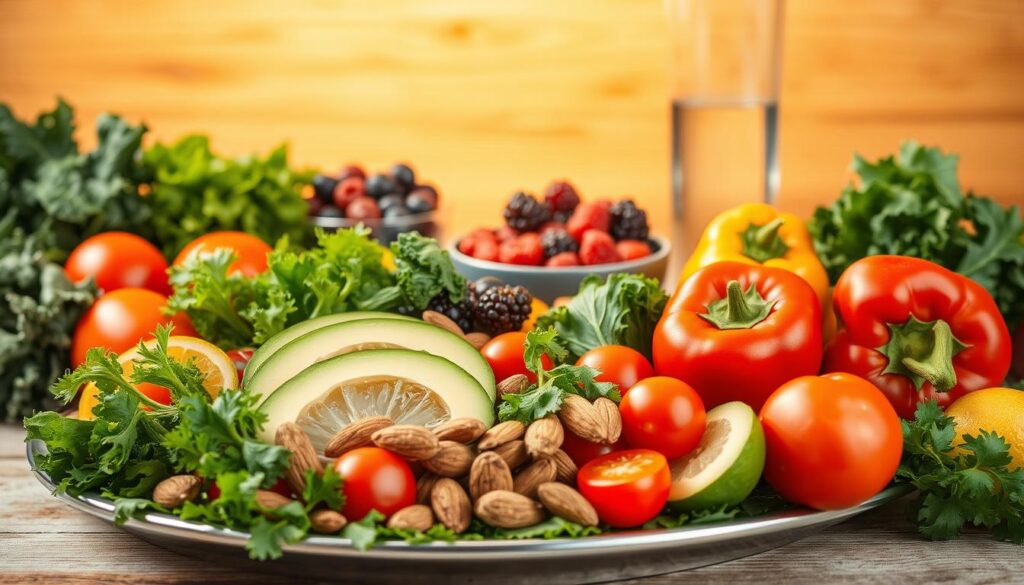Discover the Benefits of a Low-Carb Diet Today

Table of Contents
Have you ever wondered why some people achieve their weight loss goals faster than others? The secret might lie in the way they manage their carb intake. A low-carb approach focuses on reducing foods high in carbohydrates, such as pasta, bread, and sugary snacks, while emphasizing proteins, healthy fats, and vegetables.
Studies show that this method not only supports effective weight loss but also helps stabilize blood sugar levels. By balancing macronutrients, you can improve your overall health and feel more energized throughout the day. Plus, this approach is versatile and adaptable to different lifestyles, making it a popular choice for those seeking sustainable results.
Ready to explore how a low-carb lifestyle can transform your health? Let’s dive into the science-backed benefits and practical tips to get started.
Key Takeaways : Low-Carb Diet
- Reducing carbs can help with weight loss and blood sugar control.
- Focus on proteins, healthy fats, and low-carb vegetables for balanced nutrition.
- Studies show improved health markers with a low-carb approach.
- This method is flexible and suits various lifestyles.
- Practical tips and scientific advice can make the transition easier.
What is a Low-Carb Diet?
Understanding how carbohydrates impact your body is the first step to making informed food choices. A low-carb approach focuses on reducing the intake of carbohydrates, typically to less than 26% of daily calories. This method emphasizes high-quality, nutrient-dense foods over processed items.
Carbohydrates are a primary energy source, but not all carbs are created equal. Simple carbs, found in sugary snacks, are quickly digested and can spike blood sugar levels. Complex carbs, like those in whole grains and vegetables, provide sustained energy and essential nutrients.
There are several popular eating patterns that fall under the term “low-carb.” The ketogenic diet, for example, restricts carbs to less than 5-10% of daily calories, pushing the body into ketosis. The Atkins diet starts with a strict carb limit, gradually increasing as the person progresses. The Paleo diet focuses on whole, unprocessed foods, naturally reducing carb intake.
The exact amount of carbohydrates a person can consume varies based on their needs and daily calorie allotment. Some individuals thrive on very low-carb plans, while others may need a slightly higher intake to maintain energy levels. Reading product labels is crucial to identify hidden sources of carbs and make informed choices.
“The key to success with a low-carb lifestyle is finding the right balance that works for you.”
By understanding the role of carbohydrates and exploring different eating patterns, you can tailor a plan that fits your goals and lifestyle. Whether you’re aiming for weight loss, better blood sugar control, or improved energy, managing your carb intake can be a powerful tool.
Essential Components of a low-carb-diet
Building a balanced eating plan starts with understanding the essential components that fuel your body. A successful strategy focuses on three key elements: proteins, fats, and vegetables. These components work together to provide energy, support muscle health, and deliver vital nutrients.
Focusing on Proteins, Fats, and Vegetables
Proteins are the building blocks of your body. They help repair tissues and maintain muscle mass. Including ample protein in your meals ensures your body functions at its best. Lean meats like chicken, turkey, and fish are excellent sources.
Healthy fats are another crucial element. They provide long-lasting energy and support brain health. Avocados, nuts, and olive oil are great options to incorporate into your meals.
Vegetables are packed with fiber and essential vitamins. They help keep you full and support digestion. Broccoli, spinach, and zucchini are nutrient-rich choices that fit perfectly into this approach.
The Role of Fiber and Nutrient Density
Fiber plays a vital role in digestion and satiety. It helps regulate blood sugar levels and keeps you feeling full longer. Vegetables like broccoli and leafy greens are excellent sources of fiber.
Nutrient density ensures you get the most vitamins and minerals from your food. Choosing whole, unprocessed options maximizes the benefits. For example, lean meat and fresh vegetables are far more nutrient-dense than processed snacks.
“A balanced approach to eating focuses on quality over quantity, ensuring every bite counts.”
Here’s a quick guide to help you make smart food choices:
| Category | Examples |
|---|---|
| Proteins | Chicken, turkey, fish, eggs |
| Fats | Avocado, olive oil, nuts, seeds |
| Vegetables | Broccoli, spinach, zucchini, kale |
By focusing on these essential components, you can create meals that are both satisfying and nutritious. This approach not only supports your health goals but also keeps you energized throughout the day.
Meal Planning and Sample Menus
Meal planning can make or break your journey toward healthier eating habits. A well-structured plan ensures you stay consistent, avoid last-minute decisions, and meet your nutritional goals. Whether you’re aiming for weight management or better energy levels, a thoughtful approach to meals is essential.
Designing Your Daily Meal Plan
Start by balancing macronutrients—proteins, fats, and carbs. For a 2000-calorie plan, aim for 50-60% of calories from fats, 20-30% from proteins, and the rest from carbs. Use tools like food scales to measure portions in grams for accuracy.
Incorporate alternatives like cauliflower rice or zucchini noodles to reduce carb intake. These swaps keep meals satisfying while aligning with your goals. Planning ahead also simplifies grocery shopping and reduces kitchen stress.
Sample 3-Day Menu Overview
Here’s a sample menu to inspire your planning:
- Day 1: Breakfast—Scrambled eggs with spinach (3g carbs). Lunch—Grilled chicken salad (5g carbs). Dinner—Baked salmon with asparagus (7g carbs).
- Day 2: Breakfast—Greek yogurt with nuts (8g carbs). Lunch—Turkey lettuce wraps (4g carbs). Dinner—Beef stir-fry with cauliflower rice (10g carbs).
- Day 3: Breakfast—Avocado and egg toast (6g carbs). Lunch—Shrimp and veggie skewers (5g carbs). Dinner—Pork medallions with green beans (7g carbs).
Tips for Meal Prep Success
Meal prep saves time and keeps you on track. Here’s how to make it work:
- Set aside a few hours each week to cook and portion meals.
- Use airtight containers to store meals for up to 3 days.
- Label containers with calorie and carb counts for easy tracking.
- Experiment with spices and herbs to keep flavors fresh and exciting.
“Consistency is key. A well-planned meal strategy ensures you stay focused and achieve your goals.”
By following these steps, you’ll create a meal plan that’s both practical and effective. Whether you’re new to this approach or looking to refine your routine, these tips will help you stay consistent and stress-free.
Top Foods to Embrace and Limit

Choosing the right foods can make a big difference in how you feel and perform every day. Focusing on nutrient-dense options while avoiding processed items can help you maintain energy and support your health goals. Let’s explore the best choices and what to limit for a balanced approach.
Healthy Choices: Protein and Vegetables
Protein is essential for muscle repair and overall health. Opt for lean sources like chicken, turkey, and fish. Eggs are another excellent option, providing high-quality protein with minimal carbs.
Vegetables are packed with fiber and vitamins. Leafy greens like spinach and kale are low in sugar and high in nutrients. Broccoli, zucchini, and cauliflower are versatile and fit well into any meal plan.
Fruits can also be part of a healthy diet, especially those lower in sugar. Berries like strawberries and raspberries are great choices. They provide antioxidants and fiber without spiking blood sugar levels.
Foods to Avoid: Refined Carbs and Sugary Snacks
Refined carbs like white bread and pasta can cause energy crashes and spike blood sugar. These foods are often stripped of nutrients, leaving you feeling hungry soon after eating.
Sugary snacks, including candies and pastries, are high in empty calories. They provide little nutritional value and can lead to cravings. Instead, choose whole grain alternatives like quinoa or brown rice for sustained energy.
Reading labels is key to avoiding hidden sugar and refined ingredients. Look for products with minimal processing and recognizable ingredients.
“Smart food choices today lead to better health tomorrow.”
Here’s a quick guide to help you make informed decisions:
| Category | Embrace | Limit |
|---|---|---|
| Proteins | Chicken, fish, eggs | Processed meats |
| Vegetables | Spinach, broccoli, zucchini | Starchy vegetables |
| Fruits | Berries, apples, pears | High-sugar fruits |
| Grains | Quinoa, brown rice | White bread, pasta |
By focusing on these guidelines, you can create meals that are both satisfying and nutritious. Making smart choices now will set you up for long-term success.
Strategies for Dining Out and Snacking
Navigating restaurant menus doesn’t have to derail your health goals. With a few smart strategies, you can enjoy meals out while keeping your nutritional intake in check. Whether you’re at a steakhouse or a fast-food joint, making informed choices is key.
Making Smart Choices at Restaurants
When dining out, start by scanning the menu for grilled or baked options. These are often lower in carbs compared to fried dishes. Request sauces and dressings on the side to control your intake and avoid hidden sugars.
Portion management is another important factor. Many restaurant servings are larger than necessary. Consider sharing a meal or taking half home to avoid overeating. Opt for non-starchy sides like steamed vegetables instead of fries or mashed potatoes.
Here are some practical tips for dining out:
- Choose salads with grilled protein, but skip croutons and sugary dressings.
- Ask for lettuce wraps instead of buns for burgers or sandwiches.
- Check the source of ingredients and opt for simpler preparations.
Practical Snacking Ideas
Snacking can be a way to stay satisfied between meals without overdoing carbs. Focus on protein-rich options like hard-boiled eggs, cheese, or deli meat. Nuts and seeds are also great choices, but watch portion sizes to avoid excess calories.
For a sweet treat, try berries or a small piece of dark chocolate. These options provide flavor without spiking your blood sugar. Always read labels to ensure snacks align with your goals.
“Small changes in your dining habits can lead to big improvements in your health.”
If you’re unsure about specific dietary needs, consult a doctor for personalized advice. They can help you navigate potential risks and tailor a plan that works for you.
By following these strategies, you can enjoy dining out and snacking while staying on track with your health goals. It’s all about making mindful choices and finding what works best for you.
Managing Common Challenges and Side Effects

Adjusting to a new way of eating can come with its own set of challenges. While the benefits are clear, some people experience temporary side effects as their body adapts. The good news? These issues are manageable with a few simple strategies.
Combating Constipation with High-Fiber Options
One common issue is constipation, often caused by reduced fiber intake. To keep your digestive system running smoothly, aim for up to five servings of low-carb vegetables daily. Broccoli, spinach, and zucchini are excellent choices.
Fiber not only aids digestion but also helps you feel full longer. If you’re still struggling, consider adding a fiber supplement to your routine. Always pair fiber with plenty of water to maximize its effect.
Staying Hydrated and Tackling Bad Breath
Dehydration is another challenge, especially as your body adjusts to burning fat for energy. Experts recommend drinking at least 2 quarts of water daily. This helps dilute ketones, which can cause bad breath.
If traditional breath products aren’t helping, try chewing sugar-free gum or using a mouthwash designed for dry mouth. Staying hydrated also supports overall health and can improve your energy levels.
Supplementing Essential Vitamins and Minerals
Changes in your eating habits can sometimes lead to nutrient deficits. For example, folic acid and potassium levels may drop. A daily multivitamin can help fill these gaps.
Foods like yogurt, eggs, and almonds are rich in potassium and other essential nutrients. If you’re unsure about your condition, consult a healthcare professional for personalized advice.
“Small adjustments, like increasing water intake and adding fiber, can make a big difference in how you feel.”
By addressing these challenges proactively, you can stay on track and enjoy the benefits of your new eating plan. Remember, every body is different, so listen to yours and make adjustments as needed.
Tips and Tricks for Effective Carb Cycling and Preparation
Carb cycling is a flexible approach that can help you break through fitness plateaus. By alternating high and low carb days, you can optimize your energy levels and fat-burning potential. This method allows you to adjust your carb intake based on your activity levels, making it a practical choice for many.
Understanding the Benefits of Carb Cycling
Carb cycling works by varying the amount of carbohydrates you consume. On high-carb days, you replenish muscle glycogen, which can improve performance. Low-carb days shift your body to burn fat for energy, enhancing metabolic flexibility.
Studies show that this approach can improve insulin sensitivity and support weight management. For example, athletes may benefit from higher carb intake on training days, while rest days can focus on lower carb meals.
“Carb cycling tailors your eating plan to your body’s needs, ensuring you stay energized and on track.”
Prepping Meals in Advance for Consistency
Meal prep is key to sticking with carb cycling. Plan your meals around your activity levels, ensuring you have the right amount of carbs for each day. Use grain alternatives like quinoa or cauliflower rice to keep meals balanced and satisfying.
Here’s a sample meal plan for a week:
| Day | Carb Intake | Meal Example |
|---|---|---|
| High-Carb Day | 200g | Grilled chicken with quinoa and roasted vegetables |
| Low-Carb Day | 30g | Salmon with cauliflower rice and spinach |
| Moderate-Carb Day | 150g | Turkey lettuce wraps with avocado |
By prepping meals in advance, you can stay consistent and avoid last-minute decisions. This strategy ensures you meet your nutritional goals while enjoying a variety of foods.
Conclusion
Taking control of your health starts with smart, sustainable choices. Throughout this guide, we’ve explored how a well-planned approach can support weight management and overall wellness. By focusing on nutrient-dense foods like vegetables, lean proteins, and even milk, you can create meals that fuel your body effectively.
Maintaining a steady level of discipline is key to long-term success. Whether you’re meal prepping, dining out, or snacking, staying mindful of your choices makes all the difference. Remember, consistency and awareness are your greatest tools.
Use these tips as a roadmap to build a healthier lifestyle. Start small, stay committed, and watch how these changes transform your well-being. Your journey to better health begins today!
FAQ
What is a low-carb eating plan?
A low-carb eating plan focuses on reducing carbohydrate intake while emphasizing proteins, healthy fats, and nutrient-rich vegetables. It helps manage weight and improve overall health.
Which foods should I include in a low-carb meal plan?
Include foods like lean meats, fish, eggs, leafy greens, broccoli, avocados, nuts, and seeds. These provide essential nutrients and support energy levels.
Are fruits allowed on a low-carb plan?
Yes, but in moderation. Opt for low-sugar fruits like berries, which are rich in fiber and antioxidants, while limiting high-sugar options like bananas.
How can I avoid feeling hungry on a low-carb plan?
Focus on high-protein foods, healthy fats, and fiber-rich vegetables. These keep you full longer and stabilize blood sugar levels.
What are some common side effects of reducing carbs?
Some people experience fatigue, headaches, or bad breath initially. Staying hydrated and eating nutrient-dense foods can help ease these symptoms.
Can I eat out while following a low-carb plan?
Absolutely! Choose grilled proteins, salads, and steamed vegetables. Avoid bread, pasta, and sugary sauces to stay on track.
Is carb cycling effective for weight management?
Yes, carb cycling involves alternating low-carb days with higher-carb days. It can boost metabolism and support long-term weight goals.
How do I prepare meals in advance for consistency?
Plan your meals weekly, cook in batches, and store them in portioned containers. This saves time and ensures you stick to your eating plan.
Should I take supplements on a low-carb plan?
It depends on your nutrient intake. Consider supplements like magnesium, potassium, or omega-3s if your diet lacks these essential nutrients.
Can a low-carb plan help with health conditions?
Yes, it may improve conditions like type 2 diabetes, high blood pressure, and metabolic syndrome by stabilizing blood sugar and reducing inflammation.

